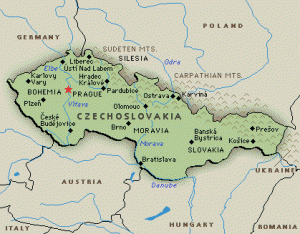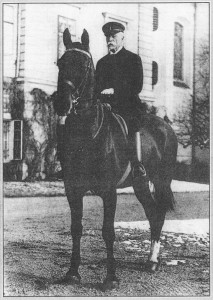The Velvet Divorce – January 1, 1993
By Tracy A. Burns
High hopes after 1989
Many had high hopes for the democratic Czechoslovakia that was reestablished after the 1989 Velvet Revolution. After all, the country had been democratic for 20 years during the First Republic (1918-1938). Plus Czech and Slovak were similar languages, and the two national identities strongly supported each other in cultural pursuits.
Yet, it was not to be. On the last day of 1992, Czechoslovakia ceased to exist, and on January 1, 1993, the two independent states of the Czech Republic and the Slovak Republic were born. How exactly did it happen? Why did they split? Historians have written numerous books on the subject.
Post-revolution arguments
 In 1989, Slovaks were not so enthusiastic about the renewed democratic Czechoslovakia. Czechs, on the other hand, considered Czechoslovakia an integral part of their identity, just as they had during the first democratic republic. The Slovaks felt oppressed. They believed they were discriminated against. Slovaks exhibited a severe allergy to Prague centralism, just as they had during the interwar years and after World War II.
In 1989, Slovaks were not so enthusiastic about the renewed democratic Czechoslovakia. Czechs, on the other hand, considered Czechoslovakia an integral part of their identity, just as they had during the first democratic republic. The Slovaks felt oppressed. They believed they were discriminated against. Slovaks exhibited a severe allergy to Prague centralism, just as they had during the interwar years and after World War II.
After the Velvet Revolution, Czechs and Slovaks could not even decide on a name for their country. Slovakia was not pleased with the name Czechoslovakia, which reinforced the notion of Prague centralism. Instead, they proposed the name to be Czecho-Slovakia, but for Czechs that brought to mind the puppet Nazi-aligned Slovak state set up in 1939 under Hitler. They finally compromised on the Czech and Slovak Federal Republic. The so-called hyphen war may seem trivial, but it was a major dispute at the time and caused much tension between the two entities.
Still, the citizens were not the ones who decided to get what has been termed “the Velvet divorce” due to the fact that there was no bloodshed. Most Czechs and Slovaks supported a referendum. In a poll taken in September of 1992, only 37 percent of Slovaks and 36 percent of Czechs favored a split. The politicians who had won seats in the 1992 elections to Parliament made the final decision.
Dissatisfaction with Czechoslovakia during 1991
Slovaks started displaying their distrust of the post-revolution Czechoslovakia long before the end of 1992. Even during 1991, Slovaks were showing their dissatisfaction, taking part in demonstrations to promote independence from the Czechs. On March 13, 1991 thousands of Slovaks gathered at Jozef Tiso’s grave in Bratislava to consecrate it, marking the 52nd anniversary of the founding of the Slovak state. Yet this Slovak state established in 1939 had been created with the consent of Hitler and Nazi Germany when many Slovaks had shown extreme nationalistic tendencies. Tiso, a Roman Catholic priest and member of the Slovak People’s Party collaborated with the Nazis as the leader of the first Slovak Republic during the war, from 1939 to 1945. After World War II, he was hanged for his support of the Nazi regime. When Czechoslovak President Václav Havel unexpectedly showed up at the consecration, he did not receive any applause. Quite the contrary. He was even attacked.
Last attempts at saving the marriage
The Slovak question became even more combustible as time went on. On November 3, 1991, when President Havel and Czech and Slovak politicians met to amend the constitution, Slovak nationalists refused to approve any of the proposals. Czech Prime Minister Václav Klaus and Slovak Prime Minister Vladimír Mečiar continually debated whether the country should be a federation or a confederation, respectively. In July of 1992, after the Slovak Parliament passed the Declaration of Independence of the Slovak nation, President Havel, who was strongly in favor of keeping Czechoslovakia together, resigned. On November 25, 1992, the Federal Assembly agreed to separate the Czech and Slovak republics into individual states.
The Great Moravian Empire and Slovak nationalism
The preamble of the new Slovak constitution states that the Slovaks are descendants of the Great Moravian Empire, when, during the 9th century, ancestors of these two nations made up its population. The territory, located on both sides of the Morava River, encompassed western Slovakia and part of Bohemia and Moravia. Founded in 833, the empire consisted of the Principality of Nitra and the Principality of Moravia. It lasted for almost 70 years until the Hungarians took over around 896. Many historians claim that there is no connection between current Slovakia and the Slovak ancestors in the Great Moravian Empire because the Slav tribes that existed then did not portray differentiating characteristics culturally or linguistically. Still, the Great Moravian Empire remains an integral part of Slovak nationalism.
Austro-Hungarian experiences
Czechs and Slovaks brought vastly different historical experiences into the short-lived, post-revolution union. From the early 10th century to 1918, their historical situations were not at all the same. The Czechs had been part of the kingdom of Bohemia and then found themselves under Austrian rule while the Slovaks had obeyed Hungary and then the Hungarian part of the Austro-Hungarian Empire. At that time, Czech industrial centers dotted the Austrian territory while agricultural Slovakia remained mostly undeveloped.
Slovaks in the first democratic republic
 Furthermore, when Czechoslovakia became a democratic state in 1918, its founder Tomáš Garrigue Masaryk joined the two nations out of necessity. Neither the Czechs nor the Slovaks were able to stand on their own, and he wanted to keep the strong German minority at bay. At the time of Czechoslovakia’s creation, Czechs made up 51 percent of the population while Germans came in second with a powerful 22 percent. The Slovaks lingered in third with 16 percent. Even during this era, Slovaks felt oppressed, not identifying themselves as Czechoslovak but rather as only Slovak. They also felt that the Czechs had colonized Slovakia via communications. For example, Czechs gained positions of authority in the railways and postal services. Czechs argued that there were not enough competent people from rural and peasant Slovakia to fulfill these posts.
Furthermore, when Czechoslovakia became a democratic state in 1918, its founder Tomáš Garrigue Masaryk joined the two nations out of necessity. Neither the Czechs nor the Slovaks were able to stand on their own, and he wanted to keep the strong German minority at bay. At the time of Czechoslovakia’s creation, Czechs made up 51 percent of the population while Germans came in second with a powerful 22 percent. The Slovaks lingered in third with 16 percent. Even during this era, Slovaks felt oppressed, not identifying themselves as Czechoslovak but rather as only Slovak. They also felt that the Czechs had colonized Slovakia via communications. For example, Czechs gained positions of authority in the railways and postal services. Czechs argued that there were not enough competent people from rural and peasant Slovakia to fulfill these posts.
Historical differences from 1938 to 1945
To better understand the country’s split, it is necessary to take a look at the historical situations following the First Republic. In 1938 a large segment of Slovakia and Ruthenia came under Hungarian control, and the Sudetenland in the Czech lands became a part of the Third Reich. During World War II, Czechoslovakia was broken up into the Nazi Protectorate of Bohemia and Moravia and the Slovak puppet state. Still, a Czechoslovak government, based in London, did fight for the nonexistent country’s rights in exile. The Germans tried to destroy Czech nationality, and Jewish communities were annihilated, though a lucky few managed to emigrate. After the war, Czechoslovakia came into existence once again, this time without Ruthenia, a territory taken over by the USSR. Czechoslovak President Edvard Beneš expelled over two million Germans from the country after confiscating their property.
Historical differences from 1946 to 1989
In 1946 Czechoslovakia rebounded. Unfortunately, because the Communist Party won the elections in the Czech lands, Communists took up posts as ministers. Yet in Slovakia the situation was different. The Democratic Party was victorious in the elections, causing even more tension between the two nations. After the February coup of 1948, Czechoslovakia officially became a Communist state. Even during the totalitarian nation that survived until 1989, there still was mistrust and misunderstanding between the Czechs and Slovaks, especially after 1969. That was when, following the crushing of the Prague Spring as rigid normalization policies were implemented, the two entities became a federation of the Czech Socialist Republic and the Slovak Socialist Republic. Such a political framework would add to the pressures that finally escalated into divorce. During the 1970s, the country became more centralized, although the president, Gustáv Husák, was Slovak.
Breaking apart
The political, cultural, and economic rifts between the Czechs and Slovaks had their roots in centuries-old history as the events that shaped the two nations vastly differed from the 10th century through the Austro-Hungarian Empire and afterward. During the Great Moravian Empire, there were no differential features between the Slav tribes, yet by the time the two entities became part of the Austro-Hungarian Empire, there were tensions galore. The Slovaks had not been so enthusiastic about the First Republic, either; they had no choice but to join forces with the Masaryk-led Czechs. During World War II, each side occupied a different position in the Nazi regime. Communist Czechoslovakia did not appease the Slovaks’ frustrations, especially after 1969. When democracy reigned once again, the Slovak question, which the Czechs had underestimated, had far from disappeared. Yet the issue was solved without the bloodshed that riddled war-torn Yugoslavia, and now both countries are members of the European Union, standing on their own.



